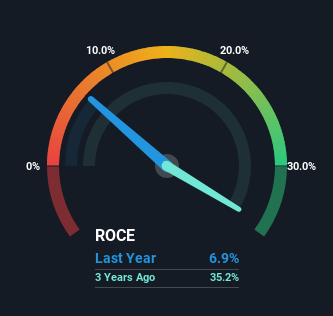- China
- /
- Auto Components
- /
- SZSE:301488
Investors Will Want Longhorn Auto's (SZSE:301488) Growth In ROCE To Persist
Finding a business that has the potential to grow substantially is not easy, but it is possible if we look at a few key financial metrics. Ideally, a business will show two trends; firstly a growing return on capital employed (ROCE) and secondly, an increasing amount of capital employed. Put simply, these types of businesses are compounding machines, meaning they are continually reinvesting their earnings at ever-higher rates of return. With that in mind, we've noticed some promising trends at Longhorn Auto (SZSE:301488) so let's look a bit deeper.
Return On Capital Employed (ROCE): What Is It?
If you haven't worked with ROCE before, it measures the 'return' (pre-tax profit) a company generates from capital employed in its business. To calculate this metric for Longhorn Auto, this is the formula:
Return on Capital Employed = Earnings Before Interest and Tax (EBIT) ÷ (Total Assets - Current Liabilities)
0.069 = CN¥89m ÷ (CN¥1.9b - CN¥606m) (Based on the trailing twelve months to June 2024).
Therefore, Longhorn Auto has an ROCE of 6.9%. On its own that's a low return on capital but it's in line with the industry's average returns of 6.9%.
View our latest analysis for Longhorn Auto

While the past is not representative of the future, it can be helpful to know how a company has performed historically, which is why we have this chart above. If you'd like to look at how Longhorn Auto has performed in the past in other metrics, you can view this free graph of Longhorn Auto's past earnings, revenue and cash flow.
How Are Returns Trending?
Longhorn Auto has recently broken into profitability so their prior investments seem to be paying off. The company was generating losses five years ago, but now it's earning 6.9% which is a sight for sore eyes. In addition to that, Longhorn Auto is employing 1,026% more capital than previously which is expected of a company that's trying to break into profitability. This can tell us that the company has plenty of reinvestment opportunities that are able to generate higher returns.
On a related note, the company's ratio of current liabilities to total assets has decreased to 32%, which basically reduces it's funding from the likes of short-term creditors or suppliers. This tells us that Longhorn Auto has grown its returns without a reliance on increasing their current liabilities, which we're very happy with.
In Conclusion...
To the delight of most shareholders, Longhorn Auto has now broken into profitability. Astute investors may have an opportunity here because the stock has declined 31% in the last year. So researching this company further and determining whether or not these trends will continue seems justified.
One more thing: We've identified 3 warning signs with Longhorn Auto (at least 2 which are potentially serious) , and understanding these would certainly be useful.
If you want to search for solid companies with great earnings, check out this free list of companies with good balance sheets and impressive returns on equity.
New: AI Stock Screener & Alerts
Our new AI Stock Screener scans the market every day to uncover opportunities.
• Dividend Powerhouses (3%+ Yield)
• Undervalued Small Caps with Insider Buying
• High growth Tech and AI Companies
Or build your own from over 50 metrics.
Have feedback on this article? Concerned about the content? Get in touch with us directly. Alternatively, email editorial-team (at) simplywallst.com.
This article by Simply Wall St is general in nature. We provide commentary based on historical data and analyst forecasts only using an unbiased methodology and our articles are not intended to be financial advice. It does not constitute a recommendation to buy or sell any stock, and does not take account of your objectives, or your financial situation. We aim to bring you long-term focused analysis driven by fundamental data. Note that our analysis may not factor in the latest price-sensitive company announcements or qualitative material. Simply Wall St has no position in any stocks mentioned.
About SZSE:301488
Longhorn Auto
Engages in the research and development, design, manufacture, and sale of automotive intelligent driving perception systems in China and internationally.
Flawless balance sheet with low risk.
Market Insights
Community Narratives


Recently Updated Narratives


Alphabet: The Under-appreciated Compounder Hiding in Plain Sight


MINISO's fair value is projected at 26.69 with an anticipated PE ratio shift of 20x


The Quiet Giant That Became AI’s Power Grid
Popular Narratives


The company that turned a verb into a global necessity and basically runs the modern internet, digital ads, smartphones, maps, and AI.


MicroVision will explode future revenue by 380.37% with a vision towards success



